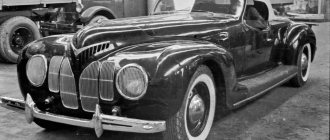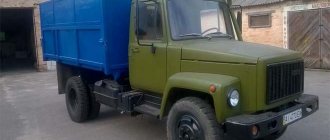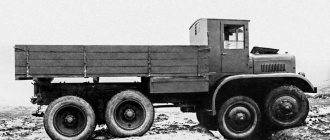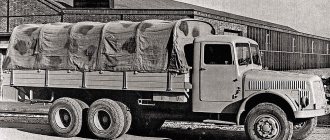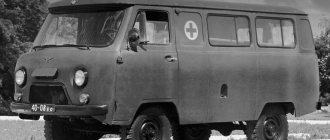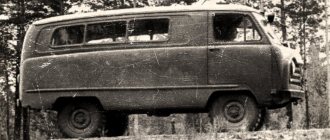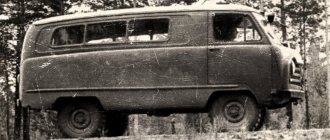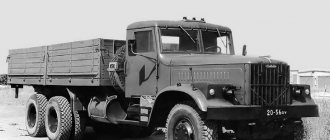The last hood with many unknowns
Mikhail Sokolov Photos by A. Novikov, L. Suslavichius and from the author’s archive
The fate of the MAZ-200P truck is in many ways paradoxical: in constructive terms, figuratively speaking, it was a deep “old man”, but with a “young man’s heart” - the latest MAZ model with a hood layout with a wooden cabin and at the same time the first with a promising new diesel engine generations. In fact, almost no one knew this car, although it had been in mass production for three years; Even an official factory photo of it simply does not exist, although literally everyone saw it with their own eyes at that time. He was mentioned in reference literature, but always very briefly, and any details about him remained “behind the scenes” for many years.
Sometimes the MAZ-200P car is called a modification of the MAZ-200, which is absolutely incorrect. In fact, it was the basic model of the transitional family, which had its own modifications. True, the model is not very common and little known. What is there! If you call a spade a spade, it was generally one of the most unknown models of the Minsk Automobile Plant, which few people knew even at the time of mass production. The 1965 MAZ factory album reported the following about it: “The MAZ-200P car is a modernized MAZ-200 car and differs from it mainly in a new, more powerful engine.”
In addition, there was a brief technical description, a diagram of overall dimensions identical to the “200” and a photo... of the usual late MAZ-200. “NIIAT’s Brief Automotive Guide” (1967) was even more laconic: “Since 1962, the plant has been producing the MAZ-200P car, which differs from the MAZ-200 car with a new YaMZ-236 engine with a power of 180 hp.” That's all.
Engine
The main difference between the MAZ-200P and the standard “200” and all its modifications was indeed the fundamentally new engine - the 4-stroke V-shaped diesel YaMZ-236, which replaced the previous YaAZ-204A/-M204A. Why YaMZ and not YaAZ? The fact is that the Yaroslavl Automobile Plant, which produced diesel engines including for MAZ, began to be called the motor plant in 1958, therefore the abbreviation of its products changed accordingly. Freed from automobile production transferred to the city of Kremenchug, YaMZ concentrated all its capacities on creating, together with NAMI, a new family of 4-stroke V-shaped diesel engines. Having manufactured and tested a number of samples, based on a combination of indicators, manufacturability and labor intensity of production, as well as ease of maintenance, we eventually settled on the version of the 6-cylinder diesel engine “019-6” with a power of 180 hp. for the Minsk Automobile Plant and a similar 8-cylinder version for the YaAZ/KrAZ models. In Yaroslavl, these diesel engines received the indices YaMZ-236 and YaMZ-238.
In order to reduce dimensions, the family was based on a V-shaped cylinder arrangement, and a more advanced workflow made it possible to ensure smooth economic characteristics in a wide range of speed and load conditions. The layout of the engines, as before, was carried out taking into account the maximum unification of components and parts for the entire family. New compact diesel engines had high efficiency, wear resistance and good starting qualities.
The YaMZ-236 diesel engine was intended primarily for installation on cars of the new promising MAZ-500 family, which was already being implemented in prototypes at that time. However, first the new engine had to be tested and compared both with the previous YaAZ-M204A and with foreign analogues. And the best way to do this was to install it on the MAZ-200 chassis. So in 1961, NAMI produced the first prototype of the MAZ-200 with the YaMZ-236 diesel engine. Strictly speaking, it was not yet the MAZ-200P, since some of the design solutions used on it differed from the subsequent Minsk incarnation. And in addition, in addition to the power unit, the MAZ-200 NAMI sample differed from the standard “200” in the rear axle with a GP gear ratio of 7.54 instead of 8.21.
Car history
During the post-war reconstruction, MAZ trucks played a significant role and were at the forefront of production. In addition, the Council of Ministers decided to promote the development of the domestic automobile industry. As a result, the MAZ-200 model was designed in 1945 in Yaroslavl, and only after testing and experiments did the truck go to the assembly line in the Republic of Belarus.
The seven-ton truck became, at that time, one of the most powerful units in mass production. By the way, the Minsk plant itself was also built with the aim of expanding automobile production. Over the next years, the Yaroslavl and Minsk factories collaborated, producing similar equipment that differed only in small details.
An example of this is the YAZ-205 and MAZ-205. Yaroslavl and several other cities also supplied components for cars. Subsequently, MAZ began to keep up with ZIL and successfully entered production, fulfilling the assigned tasks. MAZ-200 was produced until 1965.
Over twenty years, more than 230 thousand units were produced, which became part of various enterprises. A small part was able to last until the eighties with proper care. But due to progress and industrial growth, competition among models also increased. In this regard, in our time the first of the MAZs is an extreme rarity even in automobile collections.
Tests at NAMI
In 1960–1961 The experimental MAZ-200 with the YaMZ-236 diesel engine, converted by ZOK NAMI, was tested in comparison with the standard MAZ-200, as well as with foreign trucks that had 4-stroke diesel engines: the German MAN F8 (8-cylinder V-shaped, 180 hp .); Swedish Volvo Titan L3991LFХ (6-cylinder in-line, 150 hp); Czechoslovakian Škoda 706 RT (6-cylinder inline, 160 hp) and French Unic (6-cylinder inline, 150 hp).
Tests showed that the MAZ-200 with the YaMZ-236 diesel engine had a high specific power: over 14 hp. per ton without a trailer and about 8 hp. with trailer. The maximum speed of a MAZ-200 with a YaMZ-236 diesel engine, limited by the regulator, reached 75–75.5 km/h, and for a regular MAZ-200 with a YaAZ-204 engine – 60–65 km/h.
“The acceleration time of the MAZ-200 vehicle with the YaMZ-236 diesel engine,” NAMI reported on these tests, “ensures efficient operation of the vehicle with a trailer in urban conditions and on a highway with a rough profile, while maintaining the high efficiency of the vehicle. ...the dynamic qualities of the MAZ-200 car with the YaMZ-236 diesel engine can be assessed as follows: the maximum speed of the car, the minimum speed in direct transmission and acceleration time, as well as the travel of one kilometer with gear changes are high and are at the level of the best modern diesel cars of this class "
During testing, a MAZ-200 sample with a YaMZ-236 diesel engine without a trailer consumed 18.1–21.5 l/100 km. As a result, in terms of fuel efficiency, it surpassed three of the four foreign “classmates” by 15–20% - MAN, Unic, Volvo, not to mention the MAZ-200 with the YaAZ-M204 engine. And only Škoda turned out to be even more economical. However, when racing with trailers (total weight up to 30 tons), even she lost her lead.
NAMI’s conclusions based on the test results read: “The MAZ-200 car with the new YaMZ-236 diesel engine is much superior in its economic and dynamic performance to the same car with the YaAZ-204 engine. The dynamic and economic parameters of the MAZ-200 car with the YaMZ-236 diesel engine are equal to and even slightly higher than these parameters of a number of modern foreign diesel cars... When using the MA3-200 car with the YaMZ-236 engine and maintaining the existing 5-speed gearbox, the gear ratio of the rear axle is can be recommended to be equal to 7.54... In order to generally improve the economic and dynamic qualities of a MAZ vehicle with a YaMZ-236 engine, it is necessary to have a two-speed rear axle or a multiplier at the output of the gearbox, which will make it possible to have good dynamic performance with high efficiency over a wide range of loads.” .
Data from the experimental MAZ-200 tested at NAMI with the YaMZ-236 diesel engine in comparison with the serial MAZ-200 and samples of foreign diesel trucks (from the 1962 table)
| Options | MAZ-200 | MAN F8 | Volvo (Titan) L399LFX | Škoda 706RT | UNIC | |
| YaAZ-204 | YaMZ-236 | |||||
| Structural diagram | 4x2 Front engine | 4x2 Front engine | 6x2 Middle driving axle. Front engine | 4x2 With cabin over engine | 4x2 Front engine | |
| Purpose | Flatbed car | Flatbed car | Cement tanker | Flatbed car | Refrigerator | |
| Base in mm | 4530 | 4530 | 5460 | 6310 | 3990 | 5090 |
| Size in mm: | ||||||
| length | 7620 | 7620 | 8800 | 9140 | 7540 | 9000 |
| width | 2650 | 2650 | 2600 | 2345 | 2385 | 2515 |
| height | 2430 | 2430 | 3800 | 3395 | 2560 | 3610 |
| Vehicle weight in kg: | ||||||
| without load | 6400 | 6390 | 8700 | 7500 | 6000 | 9800 |
| with cargo | 13400 | 13890 | 16700 | 17000 | 13200 | 18500 |
| Weight distribution along axles in kg: | ||||||
| without load: | ||||||
| to the front axle | 3060 | 3070 | 4526 | 3590 | 3200 | 4495 |
| to the rear axle | 3320 | 3320 | 6000 | 3910 | 2800 | 5305 |
| with cargo: | ||||||
| to the front axle | 3565 | 3540 | 6000 | 5000 | 4400 | 4625 |
| to the rear axle | 10060 | 10050 | 10700 | 12000 | 9100 | 8875 |
| Load capacity in kg | 7000 | 7500 | 8000 | 9500 | 7200 | 9000 |
| Transmission | Three-way five-speed | Four-way six-speed | Three-way five-speed | Three-way five-speed | Three-way four-speed | |
| Rear axle and final drive | Rear axle drive | With final drives | Middle axle driving two-speed | Rear axle drive | Rear axle drive | |
| Final drive ratio | 8,21 | 7,54 | 7,2 | 9,36 – 6,14 | 4,87 | 5,88 |
| Tire size | 12,00 – 20 | 12,00 – 20 | 13,00 – 20 | 10,00 – 20 | 11,00 – 20 | 12,00 – 20 |
Transitional model
Already in October 1961, Yaroslavl managed to master the small-scale production of YaMZ-236, intended mainly for the Minsk Automobile Plant. However, since the development of the new family of MAZ-500 cars was delayed (problems arose with stamped elements of the cabin, etc.), at the end of 1960, a decree was issued by the Central Committee of the CPSU and the USSR Council of Ministers on the creation of transitional models of cars equipped with new engines in Minsk and Kremenchug (by the way, in the history of the Soviet automobile industry there were such precedents before; just remember the Moscow ZIS-50 or the Miass UralZIS-355V).
At the beginning of 1962, such transitional models were already mentioned in the press, for example: “The team of the Minsk Automobile Plant is preparing to replace the MAZ-200 model it produces with the 7.5-ton MAZ-500... The transition to the production of these cars will be carried out gradually as production of individual units and components that will initially be installed on MAZ vehicles of current production... Starting from the second quarter of 1962, the Minsk Automobile Plant should produce over 2,000 of these modernized vehicles under the brands MAZ-200P (flatbed) and MAZ-200M (tractor tractor).”
However, a detailed description of these models, as was customary for all new products in those years, was never published. Only a strange article by L. Karpov and Yu. Sokolov appeared, “Transitional models of cars of the Minsk Automobile, No. 7, 1962), excerpts from which are given below:
“The MAZ-200P car replaces the currently produced MAZ-200 car. Instead of the MAZ-200V tractor, the production of MAZ-200M tractors began... The modernized vehicles are equipped with V-shaped 6-cylinder 4-stroke diesel engines YaMZ-236 with a power of 180 hp. at 2100 rpm. The engine is mounted on three supports - one front and two rear. To reduce vibration, the engine is mounted through rubber shock absorbers.”
“The steering on modernized cars... consists of a screw with a rack nut meshed with a gear sector. The nut and screw have mating spiral grooves in which the balls move. To prevent the balls from falling out and returning them to the spiral groove, tubular guides are inserted into the nut. The balls move along two closed circuits. The steering gear ratio is 23.55:1.”
“Instead of lever hydraulic shock absorbers, modernized MAZ vehicles are equipped with telescopic, double-acting hydraulic shock absorbers.”
“The front springs are fastened on modernized MAZ vehicles using an overhead lug and a pin at the rear end of the springs. The front end of the spring is floating."
After reading this article, only bewilderment arose, since virtually nothing was said here about the MAZ-200P and MAZ-200M themselves, since the new steering mechanism, the new front suspension, and shock absorbers were already used at that time on the standard MAZ-200 and its modifications with conventional two-stroke diesel engines, and therefore were not at all attributes exclusively of the MAZ-200P. Now one can only guess about the reason for the appearance of such superficial material, since in fact there were really many differences between the MAZ-200P and the MAZ-200. Let's look at the main ones.
Design features
Having analyzed in detail the design of the MAZ-200 and the plan for its current modernization, the designers of UGK MAZ, for their part, came to the only acceptable solution: without changing the layout of the vehicle, place a new engine on the existing chassis without radically altering it. In terms of its overall length (1020 mm), the YaMZ-236 was even shorter than the YaAZ-M204A (1077 mm). The mounting locations for the power units also turned out to be comparable. Minor differences made it possible to get by with minimal modifications to the mounting brackets. The height of the YaMZ-236 also allowed it to be placed in the existing engine compartment of the 200th, however, the air filter housing with a diameter of 436 mm and a height of 275 mm mounted on top, in contrast to the two YaAZ-204 air cleaners located on the right side of the cylinder block, forced it to be lowered the new diesel engine was driven down as far as the V-shaped camber of its blocks allowed. At the same time, the new front suspension additionally helped to avoid unwanted contacts of the engine sump shifted downward with the front axle beam.
The greatest difficulties were caused by the width of the V-shaped diesel engine, which increased by 120 mm, because it was determined by the exhaust manifolds and cylinder heads, i.e. basic parts, the configuration of which was impossible to change, while the overall width of the narrower in-line YaAZ-M204A was determined by secondary parts of the attachments. That is, if previously it was possible to change the placement of mounted parts and free up part of the space, now it was not possible to do this. The only good thing was that the new diesel engine still fit in the existing engine compartment and easily fit into the space allocated for it on the frame. The “superfluous” thing in this case was the steering mechanism installed inside the frame, which on the MAZ-200 peacefully coexisted with the engine.
And here the new steering mechanism from the MAZ-500, being introduced into production, which was placed on the outer side of the left side member of the frame, came in very handy. Accordingly, the position of the steering column shifted to the left in the assembly with the steering wheel and their angle of inclination also changed, which was compensated by the universal joint introduced into the design. At the end of 1961, the first serial MAZ-200M tractors, which appeared earlier than onboard ones, were equipped with such steering mechanisms, and from February 1962 the time had come for the MAZ-200P.
Due to the fact that many of the service systems of the YaMZ-236 diesel engine differed from the YaAZ-M204A, they also had to be adapted to the 200th chassis. In particular, changes required a cooling system with two water pipes entering the radiator from each row of the cylinder block, while the in-line diesel engine had only one water pipe. The situation was similar with the two exhaust manifolds of the exhaust gas exhaust system, located on the side of the cylinder heads. An additional complication was caused by the fact that their outlets on the YaMZ-236 were directed backwards, and not downwards, as on the 204th, so we had to use two receiving pipes from the MAZ-500 and connect them to the muffler and exhaust pipe. The introduction of this new exhaust gas exhaust system forced the designers to modify the sloping cabin floor.
Transmission units also required significant changes. The fact is that the YaMZ-236 power unit included a 1-disc friction dry clutch with a peripheral arrangement of cylindrical springs and four release levers, as well as a 5-speed gearbox with synchronizers in 2–3 and 4–5 gears and constant mesh gears spiral tooth. However, the new command post was still in the development stage. Therefore, in order not to delay the production of complete power units, a compromise temporary solution was found in Yaroslavl - to connect the YaMZ-236 with the previous gearbox from the YaAZ-204, since in terms of the maximum permissible torque (70 kgf.m) it was also suitable for the YaMZ-236 with the maximum torque 67 kgf.m at 1400–1600 rpm.
The connecting link between them was the clutch, and here a lot of effort had to be made to connect the “old” gearbox with the new engine. The modified clutch was assigned the index YaMZ-236B. Structurally, it was an outdated YAZ-204 single-disc clutch with a new flywheel (part 236-1005120-B) and crankcase (236B-160-1010). The remaining clutch parts, including the driven disc, pressure plate and central spring, were borrowed from the clutch unit of the more powerful YaAZ-M206 diesel engine. The clutch drive remained mechanical, but was slightly changed in comparison with the MAZ-200 drive.
The cardan drive also underwent some modifications: the length of the cardan shafts was adjusted and the intermediate support outboard bearing bracket was modified to optimize the inclination angles of the cardan joints. But the rear axle, according to factory sources, on the serial MAZ-200P remained the same - with a final drive ratio of 8.21; despite successful tests of the experimental “200P” with a GP gear ratio of 7.54; and on NAMI's recommendations on the use of a two-speed rear axle or the use of a multiplier.
At the same time, the installation of a new diesel engine also introduced some simplifications into the design of the car. Since the YaMZ-236 had better starting qualities than the YaAZ-204, this made it possible to abandon complex and expensive additional devices that made it easier to start a cold diesel engine. The MAZ-200P did not have an electric torch device and an engine preheater, and, accordingly, numerous parts and controls for them on the instrument panel. By the way, the tachometer was also abolished. Minor design changes include a different fuel control drive, a “stop coin” for the engine, and a modified cabin floor with shifted coordinates of the gear lever hole.
The technical characteristics of the serial MAZ-200P differed from the technical characteristics of the MAZ-200 in the following parameters: load capacity on the highway/ground - 7000–7500/5000 kg; the largest weight of a towed trailer is 10,500 kg; curb weight – 6300–6390 kg; weight with full load – 13,525–13,890 kg; weight distribution along the axles (front/rear) without load – 3070/3320 kg, with load 7.5 t – 3515–3540 (26%)/10,010–10,050 kg (74%).
Thanks to the new powerful engine and other upgrades, the MAZ-200P was far ahead of the regular MAZ-200 in terms of its parameters and operational data, for which this transitional model was highly valued in those fleets where it managed to arrive. Although, of course, the YaMZ-236 diesel engine, launched into mass production in Yaroslavl, like any newly developed product, was sometimes “capricious” at first.
MAZ 200 history of photography (1947-1966)
On February 10, 1951, one of the revolutions in the Soviet conveyor automobile production took place. The Minsk Automobile Plant produced the first of its kind MAZ-200 flatbed truck . The car was very different from previous models and had a bison profile on the sides of the hood. The bison is considered the largest animal in Belarusian forests. For a long time it became a real symbol of the famous Minsk Automobile Plant, although popular cars had come out of its assembly line before. This model of MAZ was distinguished by a greater onboard carrying capacity. It was about 7 tons. Most factories at that time used flatbed trucks as their base model, but to revive the economy destroyed during the war, real dump trucks were needed. That is why MAZ began mass production in 1947. The production of this famous model began with the MAZ-205 dump truck model, which had a load capacity of 6 tons.
photo of MAZ-200
In the pre-war years, enterprises of the Soviet automobile industry produced mainly light-duty trucks - the GAZ-AA semi-truck and the ZiS-5 three-ton truck. Only the Yaroslavl Automobile Plant produced medium-duty vehicles and YAG-10 in small quantities. However, the need for a heavy-duty vehicle was felt quite acutely. Therefore, according to plans after the reconstruction of YAZ for 1940 - 1942, the plant was supposed to master the production of the YAG-7 truck, the prototype of which was the American GMC-803 with a 110 hp diesel engine. The first prototypes of the YAG-7 left the factory gates already in 1938. True, they used a forced engine from the ZiS-16 bus with a power of 85 hp. It was planned that the production vehicles would be equipped with a two-stage range, a frame stamped from 7 mm steel sheet, a comfortable all-metal cabin and spring suspension on rubber supports. The main axle gearbox also had to change significantly - instead of a pair of cylindrical spur gears, it was planned to use chevron ones, and instead of a bevel spur pair, gears with spiral teeth were supposed to be used.
photo of MAZ-200
The first samples of YAZ-200
were equipped with a GMC diesel engine and an all-metal cab from the American Brockway truck.
However, with the completion of testing of a two-stroke four-cylinder diesel engine, created on the basis of the American GMC 4-71 engine and named YaAZ-204, the vehicles began to be equipped with domestic engines. With a 108 mm cylinder diameter and a 127 mm piston stroke, its working volume was 6981 cm3. The operating cycle of this engine differed from the cycle of a four-stroke diesel engine and from the cycle of a two-stroke gasoline engine. Unlike the latter, the engine had a camshaft and exhaust valves. When the piston was at bottom dead center, the purge windows at the bottom of the cylinder were opened and the exhaust valve was opened. The cylinder was purged from the supercharger. Then the purge windows and valve were closed, and the piston moved up. Before the piston approached top dead center, diesel fuel was injected using a pump injector - the engine did not have a high-pressure fuel pump. The products of fuel combustion pressed on the piston, it went down, and before the bottom dead center the purge windows and the exhaust valve opened again. Before bottom dead center, the exhaust valve opens, exhaust gases are released, and then the purge windows open. The engine
developed 180 horsepower at 2000 rpm.
photo of MAZ-205
In 1946, YaAZ designers, based on a flatbed truck, developed a 6-ton YaAZ-205 dump truck, designed for transporting concrete, mortars and bulk cargo. The car was equipped with a wooden-metal cabin (due to the post-war shortage of metal), a 5-speed gearbox, pneumatic brakes and a hydraulic body lift with a volume of 3.6 cubic meters. m. Serial production of dump truck
and began in August 1947. In October 1946, the assembly of lend-lease vehicles was completed, and the plant began setting up production of trucks and special vehicles of the MAZ-200 family. The first five dump trucks marched in a convoy of city demonstrations on November 7, 1947.
The unknown person everyone knew
However, at the Minsk Automobile Plant itself, and even more so outside it, in the bright rays of the beginning triumph of the fundamentally new cabover MAZ-500, the first batches of which had already entered trial operation, the MAZ-200P was simply “lost.” There was virtually no specific detailed information about this truck. By and large, only those who were somehow involved in its release and assembly and those who then had to work on it knew about it. The model turned out to be so “in the shadow” of the first “500s” that at the moment (incredible - but true) not a single factory photograph of the MAZ-200P has been found. In those few automobile factory brochures and catalogs from 1963–1965. For some reason, publications used an ordinary MAZ-200 model of 1960 as an illustration of “200P”.
And outwardly it was quite difficult to distinguish the MAZ-200Ps seen on the roads from the usual “200s”. In reality, besides the nameplate, this could be done using only three elements: the engine, which, alas, was visible only with the hood sides removed; along the engine sump, visible only from below, where it was also difficult to look, and along the steering wheel, located much lower and at a small angle to the horizon.
This third element was the most noticeable, but I have repeatedly heard the opinion that the steering control of the MAZ-500 type cannot be evidence that this specimen is the MAZ-200P, since in the last years of production of the “200s” » the new steering was supposedly introduced on all their models.
However, this statement is not true. Firstly, it is known that the most popular of them - the MAZ-205 dump truck - until the very end of production, had exclusively the same type of steering. Secondly, in the annual years 1964 and 1965. there is not a single hint of the use of a new MAZ-500 type steering system. The only publication that described BOTH types of steering was the 1963 edition, which reflected the situation in the previous 1962. From here it is clear that they intended to begin introducing the new steering mechanism on all 200-s models, but due to the shortage of components for it, additional capital investments for such a general but short-term replacement, this idea was soon abandoned. The new type of steering was actually installed only on models with the YaMZ-236 diesel engine - MAZ-200P, MAZ-200M and all-wheel drive MAZ-501B, since it was simply impossible to mount the old steering mechanism on them. That is why separate brochures were printed for these transitional models describing the new YaMZ-236 diesel engine and the new steering mechanism. As for the MAZ-200, MAZ-200V and MAZ-205 with standard diesel engines, they continued to be equipped with the same type of steering. Therefore, the low-angle steering wheel on the late 200s can still be 100% proof that there was a YaMZ-236 under the hood of this example.
Of course, the serial MAZ-200P, which had one and a half times more power than the regular 200s, was extremely in demand in motor vehicles, and not so much as flatbed trucks, but as tractors for heavy-duty road trains. One such road train consisting of a MAZ-200P, three MAZ-5213 trailers and its driver was described in the article “Page of Best Practices” (“Automobile Transport”, No. 1, 1971):
“Many motorists in the Donbass know the name of the famous driver G.N. Meshcheryakov, who was one of the first to drive heavy-duty road trains. In one flight it delivers up to 33 tons of national economic cargo. G.N. has been working for more than a quarter of a century. Meshcheryakov in the Donetsk motor transport enterprise No. 04661...”
“Delivery of every ton of cargo by road train,” says G. Meshcheryakov, “dramatically reduces costs, and material incentives... provide the driver with high wages.” In particular, the cost of 10 tkm on Comrade Meshcheryakov’s road train is only 27 kopecks. A team of MAZ drivers, in which G.N. works. Meshcheryakov, with honor bears the title of a collective of communist labor... For his achievements in labor, Georgy Nikolaevich was awarded the Order of the Red Banner of Labor.”
Road trains led by MAZ-200P tractors, constantly towing three, four and even five two-axle trailers, were actively used not only in Ukraine, they could be found in the Baltic states, Moldova, central Russia, the Urals, Siberia and the Far East . Largely thanks to these trucks, hundreds of fleets across the country during the second half of the 1960–1970s. annually exceeded cargo transportation plans. So the MAZ-200P, along with the standard 200s, made its worthy contribution to strengthening the power and well-being of the USSR. But, unfortunately, to this day not a single onboard MAZ-200P has apparently survived.
Specifications
During the production of the 200 model, innovations began to be introduced into the Soviet automobile industry. Thus, already in the forties, synchronizers began to be installed in gearboxes. This element, as is already known, provided smoother switching between stages. An even rarer element appeared on the dashboard - a tachometer. In those days, this sensor was extremely rare.
Engine and cabin
Initially, the propulsion system of the MAZ-200 was similar to one of the American ones, but later in Yaroslavl they developed their own version, the YaAZ-204 (later 200). After the developers were convinced of the consistently high results of the machine, it was decided to modify the model for military needs.
During the conversion process, the engine became more powerful, now 120 horses, high sides of the cargo bed, folding benches and guides for the awning. The functionality was supplemented by a winch at the rear of the car. Thanks to it, the tractor could pull a load weighing up to ten tons.
But they didn’t stop developing the basic version either. Within a few years the cabin was improved. Since the stamping process was just developing, making a cabin from wood was a rather long and labor-intensive process. Subsequently, the cabin was made of individual elements, similar to what is happening now.
Brake system
A pneumatic system that operates using a receiver and compressor from the engine compartment. It often happened that the brakes failed, in which case the probability of an accident became almost 100% (the car was almost without control). Because of this, the brakes have been redesigned.
The handbrake held the crankshaft flywheel with the help of “shoes”. Popularly it was often referred to as “emergency” and was regulated by a lever to the right of the steering wheel. All four wheels were equipped with drum brakes with adjustable pads.
Chassis and steering
Steering mechanism type – worm-sector. Gear ratio – 21.5. The suspension is equipped with springs, supplemented by shock absorbers (at the rear); the rear part was similar, only supplemented with reinforcing doublers.
Mobile cranes
The MAZ factory album from 1965 reported: “The plant also produces the MAZ-200P chassis, on which various installations are mounted.”
The most famous of them were truck cranes, since this type of special equipment on the “200” chassis was initially one of the most popular. The most common model of truck crane on the MAZ-200P chassis was the K-61, which was a modernized version of the first-born crane on the YAZ-200 chassis, K-51, developed back in 1948 in Odessa.
The K-61 model was created and then mass-produced at the Ivanovo Truck Crane Plant. The K-61 truck crane was intended for loading and unloading operations and installation operations with a hook or grab and consisted of the following main components: a fixed frame mounted on the MAZ-200/MAZ-200P chassis; power take-off gearbox; slewing bearing; rotating frame; central reverse; rotation mechanism winches; block-polypast system; portal; arrows with a hook clip; control cabins and electrical equipment. The crane mechanisms are driven directly from the car’s diesel engine.
The carrying capacity of the K-61 was 6 tons; boom length – 7.35 m (with special inserts – 11.75 m); load lifting speed with a boom of 7.35/11.75 m – 10–18/15–27 m/min; rotation speed – 1.61–3 rpm; truck crane weight – 11,720 kg; overall dimensions in transport position – 10,050x3250x3860 mm; travel speed – 30 km/h.
In addition to this fairly common model, other, less well-known truck cranes were also serially installed on the MAZ-200P chassis: K-68A, K-69A, K-75, SMK-7 and MKA-10M. The K-69A was a version for the chassis of the “200th” K-64 crane, created on the basis of the K-61 with the use of pneumatic control and a more modern appearance with a separate operator’s cabin. The K-68A crane was a similar version of the K-67 crane, which became a development of the K-52 crane with a diesel-electric drive. The K-75 crane was produced by the capital's MEMZ and was a hydraulically controlled version of the K-53 crane, a 7.5-ton grabless modification of the K-51. The Ivanovo crane SMK-7 was special and had a diesel-electric drive. And finally, the MKA-10M crane, developed by the Central Design Bureau UMSM of the Ministry of Construction of the RSFSR, was a new independent design, which in terms of performance approached the K-104 crane. In addition, experimental designs of truck cranes were also mounted on the MAZ-200P chassis, for example, a copy of the experimental 10-ton crane of the Ivanovo plant made in 1964.
Due to the specifics of operation, the age of truck cranes was much longer than that of on-board vehicles. Therefore, it is not surprising that the very last copy of the MAZ-200P (and maybe even copies, who knows?) came to us in the form of the K-61 truck crane. At least a few years ago, this unique item “popped up” in Latvia on a website selling various equipment.
